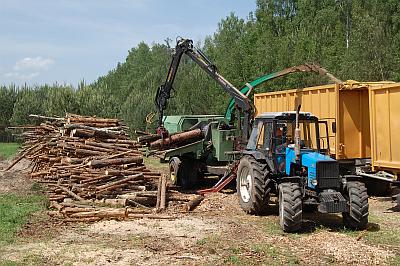Geneva
 This year, for the first time, national experts from both the forestry and energy sectors in the Commonwealth of Independent States and Turkey came together to examine policy options for accelerating the production and use of cost-effective wood energy in the region.
This year, for the first time, national experts from both the forestry and energy sectors in the Commonwealth of Independent States and Turkey came together to examine policy options for accelerating the production and use of cost-effective wood energy in the region. They concluded that wood energy not only contributes to energy security but also stimulates sustainable social and economic development, especially in rural areas. However, in some countries, it still needs greater political commitment, both locally and nationally.
The event was a regional workshop entitled “Policy Options for Wood Energy in CIS Countries”. It was organized in Minsk by the Belarus Ministry of Forestry, together with the Food and Agriculture Organization (FAO) subregional office for Central and Eastern Europe, the United Nations Development Programme office in Belarus, the United Nations Industrial Development Organization and the Geneva-based United Nations Economic Commission for Europe (UNECE)/FAO Forestry & Timber Section on 1-4 June 2010.
Belarus has 33 wood-energy facilities, which are producing over 500,000 tonnes of woodchips every year. This output is expected to double by 2020. In many other countries in the region, however, wood energy plays a less significant role in the energy portfolio.
To raise the profile of wood energy throughout that region, the experts recommended that public and private bodies concerned with energy and with forest management should work on achieving improved policy coherence and cooperate more closely. They also recommended that countries should use internationally recognized standards for wood fuels and energy-generation equipment.
Representatives of nine countries in the region* reported on the status of wood energy in their countries. It is clear that the use of wood energy is mostly related to a country’s forest coverage and fossil fuel resources. As well as Belarus, some countries in the region are already using wood energy extensively, especially the Russian Federation. The Russian Federation has a well-developed wood-energy industry, which consumes 28 million cubic metres of firewood per year. In other countries, lack of infrastructure limits access to remote areas, thereby hampering the mobilization of wood. Participants nevertheless highlighted the potential contribution of wood from sanitary fellings to localized wood energy production in rural areas.
Participants agreed on the fundamental importance of obtaining robust data on wood-energy sources, and expressed their appreciation of the work of the UNECE/FAO Forestry and Timber Section. To assess the weight of wood energy in national energy supplies, together with the European Union and the International Energy Agency the Section has since 2005 been conducting a region-wide survey on wood energy, the Joint Wood Energy Enquiry. The next update will be launched in autumn 2010.
For further information, please contact:
David Ellul
UNECE/FAO Forestry & Timber Section
Palais des Nations, CH-1211 Geneva 10
Switzerland
phone: +41 22 - 917 1390 - fax: +41 22 - 917 0041
email: [email protected]
web: www.unece.org/timber
Ref: ECE/TIM/10/P10